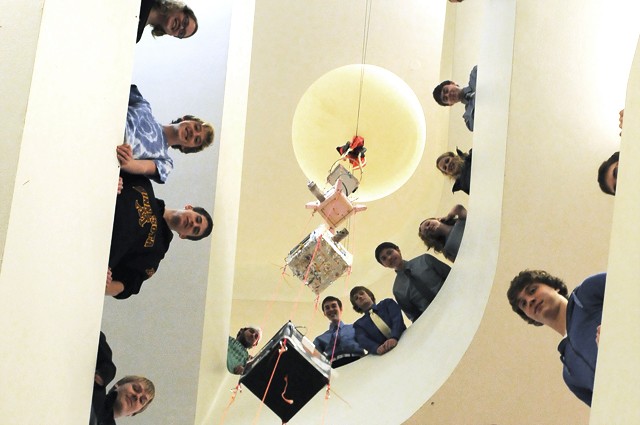Few people make it to space, but some first-year students at the University of Minnesota can get pretty close. A seminar course offered through the Aerospace Engineering and Mechanics Department called âÄúSpaceflight with BallooningâÄù allows students to conduct experiments close to outer space using high-altitude balloons. On Oct. 30, after half a semester of planning and preparation, groups in the class released a high-altitude balloon filled with helium into the atmosphere. The balloon rose to an altitude of 112,000 feet until it burst and descended back to the ground, according to Dr. James Flaten, the professor for the course. âÄúThis gets into the ozone layer,âÄù Flaten said. âÄúThe temperature gets down to negative 60 or negative 70 degrees Celsius. Then it goes up again as the atmosphere absorbs heat.âÄù Each of the four teams from the 20-person course created âÄúpayload boxes,âÄù which held measuring equipment used for different experiments. The boxes were designed to withstand the harsh environment of the upper atmosphere. Now safely back on Earth, the four boxes hang from the ceiling of Ackerman Hall, dangling between multiple flights of stairs and sporting posters of each groupâÄôs results. One payload box was from a group called The Roaches, named for their original idea of sending cockroaches up to see if theyâÄôd survive. Their data showed a correlation between temperature and solar panel efficiency. Two graphs, one showing voltage measurements from a series of solar panels and another showing internal temperature, were almost exactly inverse to each other. âÄúIt may be because of altitude or because itâÄôs cold,âÄù said Kelsea Schaefer, a first-year biomedical engineering student who helped design the payload box. She said the voltage measured increased as altitude increased. The payload box from Team Icarus was jet black, save a white spray-painted skull. âÄúWe called it Zombicarus,âÄù said Max Sjöberg, a member of Team Icaurs, citing the Halloween release date. Sjöberg said the course was a great hands-on experience. âÄúInstead of sitting around analyzing other peopleâÄôs problems, you create your own problems,âÄù he said. While Sjöberg is looking to major in language, he says he would consider another course in aerospace engineering. âÄúIt definitely sparked an interest,âÄù he said. Flaten discussed how high-altitude balloons offer a cheap alternative to sending rockets into space. âÄúThat package there cost us maybe $300 or so,âÄù he said, using the Team Icarus box as an example. âÄúIf I wanted to put that in outer space, it would cost $200,000.âÄù The low cost of ballooning makes it ideal for other forms of research. âÄúOverall scientific ballooning is very active. It has produced fantastic results over the last 40 or 50 years at a small fraction of the cost of a NASA satellite,âÄù said Shaul Hanany, professor of physics and astronomy at the University. Hanany uses equipment sent on high-altitude balloons to measure âÄúcosmic microwave background radiation.âÄù His results were deemed âÄúone of the 10 most important breakthroughs in science for the year 2000âÄù by Science magazine. âÄúWe just sent a payload on a test flight for a project that will search for signatures of what happened a trillionth of a trillionth of a trillionth of a second after the big bang,âÄù Hanany said. Hanany said the first-year seminar class is a good introduction to what high-altitude ballooning can provide for research. âÄúI think itâÄôs excellent training for the students in trying to prepare a payload for harsh conditions,âÄù he said. While this is the second year the fall semester course has been provided, Flaten said nothing has been determined for next year.

Image by Chelsey Rosetter
First-year students from Dr. James Flaten’s freshman seminar, Spaceflight with Ballooning, stand by payload boxes they designed and built during the semester. The class launched the boxes along with a helium high-altitude balloon and parachute on Oct. 30.
Students’ balloons sent near space
A University course allows students to conduct experiments close to outer space.
Published November 29, 2009
0

